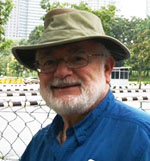By Oliver B. Pollak

RICHMOND, California – I started contributing to San Diego Jewish World in November 2017. About 100,000 words later this is my 102nd story. The ingredients are facts, imagination, inspiration, rigor, memory and the compulsion to write. Wife Karen and editor Don are faithful and critical readers.
Tammi M. Owens, a student from over a decade ago, the co-author of The 360 Librarian: A Framework for Integrating Mindfulness, Emotional Intelligence, and Critical Reflection in the Workplace (2020) appreciated an SDJW article and asked me about research organization: “I need to write and publish the shorter items that are gamboling around in my head. How do you organize your ideas on the computer? Do you have files with your pre-writing? Now that I’m tenured I need to get a system in place to keep me honest in my efforts. My latest idea is to create folders for each project and put associated notes and lit reviews in each folder, even if it’s the faintest germ of an idea.”
Writing for SDJW uses time once consumed by teaching and practicing law. I offer this advice in the tradition of “Letters to” my son, daughter, grandson, granddaughter, and so forth. I italicized Tammi’s words still alien to me, which my exasperated wife has repeatedly implored me to adopt. Thank you for the suggestion. Why fix what isn’t broken, but embrace more useful technological innovation.
The “faintest germ of an idea” may be a suggestion, a hint, a scent. Stimulating surroundings prompt short form stories. The moment an idea seems to have potential my moleskin comes out from my left trouser pocket. If it has wheels or maintains my interest, I “open” a 9 x 12 catalog envelope, much thinner than manila files, which I buy by the hundreds from Office Depot, then trim and slit them open, to receive notes, ideas, data, scraps, an aroma free potpourri of ephemera, rough drafts and the finished product, though increasingly “finished products” are bricks in “under construction.”
The puzzle of the cache or tranche is locating it. Over half a century of files are spread out over four floors and the garage. I know if I can answer you in 1,000 words there will be a story for a publisher somewhere. The shortest answer: anything goes that seems to work until it fails. Failure comes from misplacing paper, notes, not finding it on the computer, and temporarily not lassoing a good idea you think you had, and are certain was not a dream. Choose a mnemonic that will still resonate six months later.
Everyone is different. Variables include age, gender, cognitive styles, and subject. Non-fiction writers vouch for the authenticity of their work by crediting their evidence. The path of rigor and imagination is fruitful. I’ve published eleven books with two or three in the works, currently between 20,000 to 60,000 words. I have published about 800 shorter essays in the 300 to 5,000 word range. Rejections – “not for us, this has already been done, nothing new, try another journal, we’ll take a pass on this one, keep us in mind for future work” are occupational nuisances. Maintain good relations with librarians and editors. I have not yet self-published but know brilliant scholars take this path in their eighties. What you do not finish while you are alive will rarely get published posthumously.
The thrill of the chase, discovery, long pleasurable hours, competence, acknowledging the people who assisted me, seeing my name in print, increasing the quantum of knowledge, and an appreciative readership are my compensation. Compulsion — the more you do the more you get done. Technology makes it easier. Pencil, fountain and ball point pens, manual typewriter, and selectric IBM were ascending technologies not so different from cuneiform. Miniature microfilm text induced headaches. But the laptop, internet and digitized documents has revolutionized my profession.
The hardest thing to control is distraction. What I am doing now is a distraction from several larger projects on the anvil. Working multiple projects means they take longer to emerge, which is good because you have more time to roll them around. “ Clock’s Ticking, Can Deadlines bring us to life” by Rachel Symes (New Yorker, July 5, 2021) revels in the brains plasticity. In school you took several classes at once, you had a major and a minor, you studied languages, all this utilized the brain’s ability to make categories and cerebrally internalize the most efficient use of consciousness and sleep. I go to sleep perfecting sentences, and organization.
From junior high school onward I kept 3×5 cards with ideas for development, things about which I wanted to know more. I kept notes on 8 ½ x 11, 8 ½ x 5 ½ and now 4 ¼ x 5 ½ pieces of paper. Typists no longer get gloried for their patience and handling first drafts and working toward the final presentable to editor product, using scissors, paste, scotch tape, glue, pins, paperclips and dog ears. Then came post-its.
I cut my academic teeth on my doctoral dissertation in the early 1970s. Ph.D. in hand I had my union card. I owe a great debt to my teachers and Jacques Barzun’s The Modern Researcher. Fifty years later I read somewhat older scholars, John McFee, Robert Gottlieb and Robert Caro, the work of my contemporaries and younger scholars. The research and writing process is a lifelong education.
It is one thing to prepare 1,000 words where you can see the sentences and paragraphs with ease. Challenge increases with length. Wrestling 50,000 or more reader friendly words welcomes distraction, divagation and digression, a temporary escape. But leaving the main task for too long may be fatal. The aesthetic, esoteric, ethereal, existential and obscure, the common, mundane and quotidian deserve their place. Haikus at 17 syllables are good exercise long form prose.
*
Oliver B. Pollak, a professor emeritus of history at the University of Nebraska Omaha, and a lawyer, is a correspondent now based in Richmond, California.